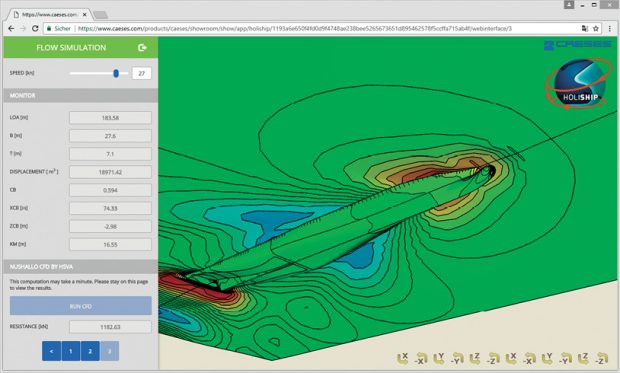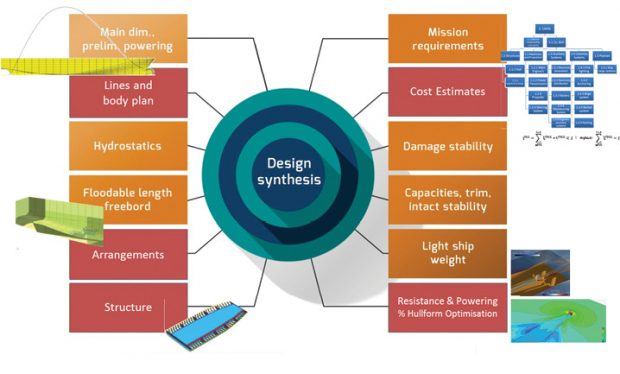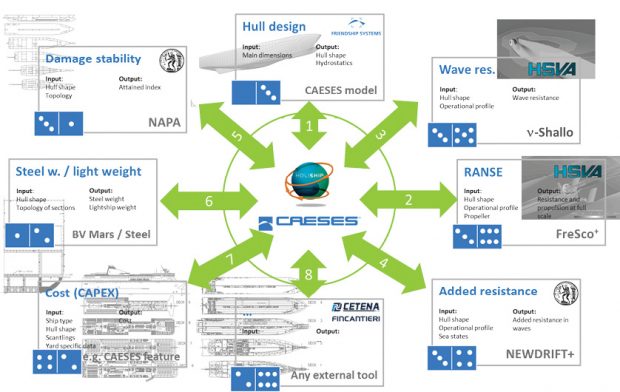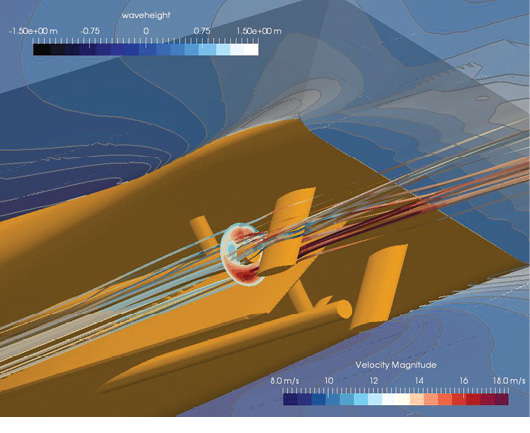
HSVA’s nu-Shallo flow code for hull wave resistance is coupled within CAESES and offered as a web app by means of a software-as-a-service technique.
Latest News
December 1, 2017
Like the development efforts of large-scale entities such as rocket ships, wind turbines and aircraft, ship design is becoming more complex. With requirements that call for hundreds of interconnected systems and governance by a mounting list of regulations, a 40-plus-member European maritime industry consortium is pushing for wholesale changes to longstanding ship design and testing practices.
The initiative, dubbed HOLISHIP (HOLIstic Optimization of SHIP Design and Operation for Life Cycle), was born from the European Commission within the HORIZON 2020 Transport Programme, which is serving up nearly 80 billion euros in funding to drive economic growth and innovation in the European Union (EU). The HOLISHIP R&D initiative, which received a 11.3 million euro grant, set sail in September 2016 to develop a next-generation blueprint for designing and assessing the performance of ships. The idea is to evolve the EU’s ship-building industry from a traditional iterative design approach to a more holistic view that spans the entire lifecycle while incorporating state-of-the-art, multi-objective optimization, multidisciplinary simulation, and virtual prototyping and testing tools into standard design workflows.
 HOLISHIP’s Design Synthesis approach uses complex multidisciplinary optimization techniques to arrive at the optimal ship design. Images courtesy of HOLISHIP.
HOLISHIP’s Design Synthesis approach uses complex multidisciplinary optimization techniques to arrive at the optimal ship design. Images courtesy of HOLISHIP.“Ship design is always a challenging task involving many disciplines, significant experience and the collaboration of as many experts as possible, but the ways of designing ships over the years have not changed much,” explains Apostolos Papanikolaou, senior scientific advisor to HOLISHIP and a professor at the National Technical University of Athens (NTUA). “Now with better hardware and software, we’re able to integrate software tools on a platform to do the work that many experts would have done manually and in a serial way.”
Powering Design Synthesis
The key to the HOLISHIP concept is the Design Synthesis concept, an approach that considers all the global trade-offs and parameters at the onset of the ship design stage—for example, operational and technical requirements, cost and profitability management, environmental and recycling requirements, lifecycle needs, technical performance objectives, and normative constraints, among other factors. As opposed to traditional design practices that follow a serial process for weighing trade-offs between different disciplines, objectives and design parameters, HOLISHIP advocates for a holistic approach where multidisciplinary optimization techniques and software tools are leveraged to move beyond a handful of workable ideas to a broader design space optimized for different requirements.
 The CAESES software serves as the foundational platform for coupling disparate simulation and optimization tools in a way that facilitates non-expert participation.
The CAESES software serves as the foundational platform for coupling disparate simulation and optimization tools in a way that facilitates non-expert participation.With the existing design spiral approach, one group might begin a design concept starting with the main dimensions of a ship, then move a rough idea to another group that considers parameters like structure and stability before moving on to yet another team focused on ergonomics or hydrodynamics, for example. The whole process typically happens sequentially, which greatly limits design exploration, according to Dr. Stefan Harries, MSE, managing director of Friendship Systems, one of the key partners on the HOLISHIP project.
“With a sequential design process, you can only look into a handful of variants because it takes time and you have to bring in knowledge and expertise,” he explains. “You might start with something you know would work and step-by-step, you advance the design to get closer to the end point. In this scenario, you get something feasible, but not necessarily optimal.”
 Shown is a propulsion simulation using a hybrid RANS-BEM coupling for the design of a RoPAX ferry.
Shown is a propulsion simulation using a hybrid RANS-BEM coupling for the design of a RoPAX ferry.The proposed Design Synthesis approach enables engineering teams to consider many more variants due to the ability to interconnect different disciplines like hydrodynamics or cost, he says. “By the means of Design Synthesis, you can better understand the cause and effect of various variants and get to the sweet spot,” he explains.
With multidisciplinary optimization at the heart of the Design Synthesis approach, stakeholders throughout the various stages of a ship’s lifecycle benefit in many ways, according to HOLISHIP officials. For example, shipbuilding yards and engineering companies stand to profit from reduced design cycles and the ability to better satisfy customer needs due to exploration of a larger design space. The supplier ecosystem will enjoy an optimized production process that reduces cost and time to market while ship owners can better achieve optimized operations and lower maintenance costs, helping to maximize ship ROI, they claim.
Three-Cluster Plan
To support the Design Synthesis concept, HOLISHIP envisions a three-stage design platform that covers concept design, contract design and virtual testing. The first cluster will foster tools to support optimization methods across all stages of the ship design and operation lifecycle, from early market analysis to system architecture. The second cluster aims to create an integrated development environment and virtual testing platform for ship design. The third cluster will encourage development of highly specific applications that utilize that integrated development platform, covering vertical areas like simulation of off-shore vessels, for example, or for handling maintenance for cruise vessels or other complex ships, explains Dr. Jochen Marzi, project manager for HOLISHIP and director, CFD and research, for HSVA and the Hamburg Ship Model Basin.
Friendship System’s CAESES process integration and design optimization system will serve as the basis for the main HOLISHIP development platform. CAESES couples any tool used to explore different disciplines and parameters and creates an environment for standard process integration. As part of the HOLISHIP effort, the group will work to make the tool more accessible to non-tool experts by simplifying the process integration environment and exploring new usability models like the cloud, Harries says.
“We are aiming to wrap the tools in such a way that less experienced users will be able to run them and create a process chain of how things work together,” he explains.
 HSVA’s nu-Shallo flow code for hull wave resistance is coupled within CAESES and offered as a web app by means of a software-as-a-service technique.
HSVA’s nu-Shallo flow code for hull wave resistance is coupled within CAESES and offered as a web app by means of a software-as-a-service technique.The other primary piece of the HOLISHIP development environment is the Virtual Vessel Framework, essentially a virtual test bed platform that will be based on DLR’s RCE technology and workflow engine. HOLISHIP’s Marzi is careful to point out that the VVR virtual testbed is not a digital twin, meaning it is not a digital representation of an entire ship’s systems. Rather, the VVR is a virtual environment where ship builders can test various components and systems in the digital world to evaluate and compare performance characteristics as they evolve vessel designs.
Just into its second year, Marzi says the consortium is pleased with the progress of the HOLISHIP vision and says he’s confident the organization will have a competitive and marketable commercial environment available for the EU maritime industry by 2020. HOLISHIP is not envisioned as a monolithic development platform; rather, it is being designed as a system that pulls together various components from different providers, thus it can be configured and customized to individual players’ needs.
In the end, the HOLISHIP vision is to make the next-generation optimization tools already widely in use in industries like aerospace and automotive available to the EU maritime industry, which tends to be more conservative. In addition to democratizing the tools, the initiative aims to coalesce the entire ecosystem on a common platform to facilitate a frictionless exchange of complex information between parties.
Marzi says: “At the end of this project, we hope there is more democratization of analysis software, which in turn will lead to better utilization and completely novel ship designs.”
More Info
Subscribe to our FREE magazine, FREE email newsletters or both!
Latest News
About the Author
Beth Stackpole is a contributing editor to Digital Engineering. Send e-mail about this article to [email protected].
Follow DE





